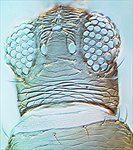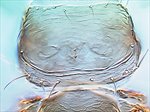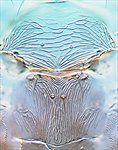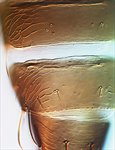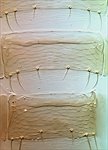Generic diagnosis
Female macropterous. Head as long as wide or longer; maxillary palps 2- or 3-segmented; eyes without pigmented facets; ocellar setae I absent, pair II as long as III; five pairs of long postocular setae, pair I longest, not arranged in a straight row. Antenna 7-segmented; segment I without paired dorso-apical setae; III and IV with short forked sense cone; III–VI with microtrichia on both surfaces. Pronotum transverse, with two pairs of posteroangular setae; without discal setae. Mesonotum with no sculpture or campaniform sensilla on anterior third; median pair of setae far from posterior margin. Metanotum with irregular longitudinal striae, median setae far from anterior margin; campaniform sensilla present or absent. Fore wing first vein with setal row incomplete, two setae distally; second vein with setae widely spaced distally; clavus with four veinal and one discal setae; posteromarginal fringe cilia wavy. Prosternal ferna not divided; basantra membranous, without setae; prospinasternum slender and transverse. Mesosternal furca usually without spinula; metasternal furca without spinula. Tarsi 2-segmented; hind tibia with two or three setae longer than tibial width. Tergites without craspeda, V–VIII with paired ctenidia laterally, on VIII antero-mesad of spiracles; comb on VIII represented by a few microtrichia laterally; IX with anterior campaniform sensilla absent; X with incomplete split. Sternite II with two or three pairs of marginal setae, III–VII with three pairs, S1 arising at or in front of margin.
Male similar to female, sternites usually with pore plates.
Biological data
The three species in this genus are all associated with grasses (Poaceae), presumably feeding and breeding on the leaves.
Distribution data
Two species in this genus are from Europe, but the third species is from eastern China.
Nomenclatural data
Baliothrips Uzel, 1895: 204. Type species Thrips dispar Haliday 1836, by monotypy.
Three species are placed in this genus (ThripsWiki, 2020); two are widespread in Europe, but the third is known only from eastern China:
sunae Zhang, Wang, Li & Mound, 2018: 371
Relationship data
Thripidae sub-family Thripinae: this is a diverse group involving more than 230 genera. The species of Baliothrips share with the species of Stenchaetothrips and Fulmekiola the almost striate sculpture on the metanotum. One European species, Baliothrips kroli, is placed by zur Strassen (2003) in a separate monobasic genus because of the presence of a pair of longer setae on the anterior margin of the pronotum, and also the presence of 3-segmented maxillary palps. However, kroli and dispar exhibit a remarkable synapomorphy involving an extra pair of setae medially on the second abdominal sternite. The species described from China lacks this pair of setae.
References
Bhatti JS & Mound LA (1981) The genera of grass and cereal-feeding Thysanoptera related to the genus Thrips (Thysanoptera: Thripidae). Bulletin of Entomology, India 21 (1980): 1–22.
Zhang SM, Wang ZH, Li YJ & Mound LA (2018) One new species, two generic synonyms and eight new records of Thripidae from China (Thysanoptera). Zootaxa 4418 (4): 370–378.
